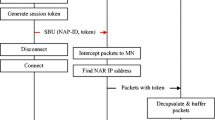Abstract
In the mobile communication environments, Mobile IP is defined to provide users roaming everywhere and transmit information freely. It integrates communication and network systems into Internet. The Mobile IPv6 concepts are similar to Mobile IP, and some new functions of IPv6 bring new features and schemes for mobility support. Two major problems in mobile environments are packet loss and handoff. To solve those problems, a mobile management scheme – the cellular mobile IPv6 (CMIv6) is proposed. Our approach isbased on the Internet Protocol version 6 and is compatible with the Mobile IPv6 standard. Besides, it also combines with the cellular technologies which is an inevitable architecture for the future Personal Communication Service system (PCS). In this paper, {Cellular Mobile IPv6 (CMIv6)}, a new solutionmigrated from Mobile IPv6, is proposed for mobile nodes moving among small wireless cells at high speed. This is important for future mobile communication trends. CMIv6 can solve the problems of communication break off within smaller cellular coverage during high-speed movement when packet-switched data or the real-time voice messages are transmitted. Voice over IP (VoIP) packets were chosen to verify this system. The G.723.1 Codec scheme was selected because it has better jitter resistance than GSM and G729 in a packet-based cellular network. Simulation results using OPNET show smooth and non-breaking handoffs during high-speed movement.
Similar content being viewed by others
References
I.F. Akyildiz et al., “Mobility Management in Current and Future Communications Networks”, IEEE Network, 1998.
J. Wu, “An IP Mobility Support Architecture for the 4GW Wireless Infrastructure”, PCC’ 99, 1999.
N.D. Tripathi, J.H. Reed and H. F. Vanlandingham, “Handoff in Cellular System”, IEEE Personal Communications, pp. 26–37, 1998.
C. E, Perkins and K.Y. Wang, “Optimized Smooth Handoff in Mobile IP”, IEEE International Symposium on Computers and Communications Proceedings, pp. 340–346, 1999.
S. Seshan, “Low-Latency Handoff for Cellular Data Network”, PhD Thesis, University of California at Berkeley, 1995.
R. Caceres and V.N. Padmanabhan, “Fast and Scalable Wireless Handoff in Support of Mobile Internet Audio”, Mobile Network and Applications, 3, pp. 351–363, 1998.
W. Woo and V.C.M. Leung, “Handoff Enhancement in Mobile-IP Environment”, in Proceedings of ICUPC – 5th International Conference on Universal Personal Communications, Sept. 29–Oct. 2, 1996.
D. Forsberg et al., “Distributing Agent Hierarchically under Frequent location Updates”, IEEE International Workshop on Mobile Multimedia Communications (MoMuC’ 99), pp. 159–168, 1999.
K. Weng Ng and V.C.M. Leung, “An IPv6-Base Location Management Scheme for Client-Server Computing over Mobile Data Networks”, IEEE Wireless Communications and Networking Conference, pp. 525–529, 1999.
W. Su and M. Gerla, “IPv6 Flow Handoff in Ad Hoc Wireless Networks Using Mobility Prediction”, in Proceedings of IEEE GLOBECOM’ 99, Rio de Janeiro, Brazil, Dec. 1999.
G. Chiruvolu et al., “Mobility and Qos Support for IPv6-Based Real-Time Wireless Traffic”, in IEEE International Conference on Communications (ICC’ 99), Vol. 1, pp. 334–338, 1999.
Eid and Nadim, “IPv6 Mobility Support for ‘Micro-Cell’ Networks”, http://www.cs.Columbia.edu/~enadim/ee6950.html
C. Castelluccia, “A Hierarchical Mobile IPv6 Proposal”, Nov. 1998.
H. Soliman et al., “Hierarchical MIPv6 Mobility Management”, Internet Draft, draft-ietf-mobileip-hmipv6-03.txt, Feb. 2001, Work in Progress.
A.G. Valko, “Cellular IP: A New Approach to Internet Host Mobility”, ACM Computer Communication Review, 1999.
H.-Ch. Chao and Y.M Chu, “An Integrated Mobile Communication Infrastructure for the Next Generation PCS Systems Using IPv6”, International Conference on Parallel and Distributed Processing Techniques and Applications (PDPTA’ 99), Las Vegas, NV, U.S.A., June 28–July 1, 1999.
H.-Ch. Chao and Y.M. Chu, “Seamless Supports for the Mobile Internet Protocol Based Cellular Environments”, International Journal of Wireless Information Networks, Vol. 8, No. 3, pp. 133–153, 2001.
J. Finney and A. Scott, “Implementing Mobile IPv6 for Multimedia”, in Proceedings of the GEMI-SIS/ IEE/BCS Symposium on Multimedia Network Technology, Digest Number G/MNT/1/1998(e), Salford, U.K., May 1998.
R. Ghai and S. Singh, “Maintaining Seamless Communication between Mobile User – An Architecture and Communication Protocol for Picocellular Networks”, IEEE Personal Communication, 3rd Quarter, 1994.
H.C. Chao, Y.M. Chu and T.G. Tsuei, “Codec Schemes Selection for Wireless Voice over IP (VoIP)”, Lecture Notes in Computer Science, Vol. 2195, pp. 622–629, Springer, 2001.
K.M. Liu and H.-Ch. Chao, “Virtual Private Networks in Cellular Mobile IPv6 Architectures”, TANET 2001, Chia-Yi, Taiwan, ROC, 2001.
Y.-M. Chu, “Smooth Handoff for the Next Generation Cellular Mobile System: Cellular Mobile IPv6”, Master Thesis, National Dong Hwa University, Taiwan, July 2000.
Author information
Authors and Affiliations
Rights and permissions
About this article
Cite this article
Chao, HC., Chen, WM. & Chu, YM. A Low Latency Handoff Algorithm for Voice over IP Traffics in the Next Generation Packet-Based Cellular Networks: Cellular Mobile IPv6. Wireless Personal Communications 23, 353–378 (2002). https://doi.org/10.1023/A:1021259429609
Issue Date:
DOI: https://doi.org/10.1023/A:1021259429609




